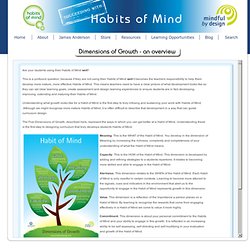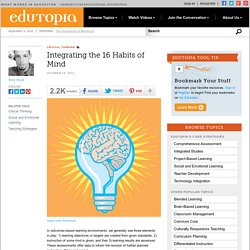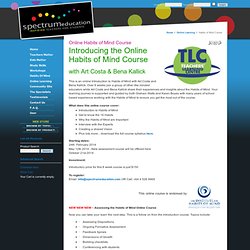

WonderGroveLearn.com. Habits of Mind. Habits for success in school and life SmartBlogs. Take a moment to join us in a snapshot of a classroom we recently observed: Students are hard at work designing a travel brochure as a part of their study of Ireland.

They need to think about how much it will cost by air or by sea and develop a good rationale for why one way is preferable to another. They will also be including a recommended sightseeing schedule, determining why one schedule would be preferable to another. These students have to analyze, evaluate, make decisions and communicate to an audience. As a group, they must work through this using the best of each student’s contributions to create their product.
Dimensions of Growth - an overview. Are your students using their Habits of Mind well?

This is a profound question, because if they are not using their Habits of Mind well it becomes the teachers responsibility to help them develop more mature, more effective Habits of Mind. This means teachers need to have a clear picture of what development looks like so they can set clear learning goals, create assessment and design learning experiences to ensure students are in fact developing, improving, extending and maturing their Habits of Mind. Understanding what growth looks like for a Habit of Mind is the first step to truly infusing and sustaining your work with Habits of Mind. Although we might recognise more mature Habits of Mind, it is often difficult to describe that development in a way that can guide curriculum design. The Five Dimensions of Growth, described here, represent the ways in which you can get better at a Habit of Mind. Meaning: This is the WHAT of the Habit of Mind. Capacity. Alertness. Value. Habits of Mind. Persistence does not equal failure.
Sometimes students think that if they need to persist at a task in class then they must not be smart enough.

They learn not to value persistence because they see it as a sign that they are not smart enough to "get it" the first time. Of course that's a generalization, but there's more than a little truth to it as well. This series of blog entries is about the Teachers Handbook that we all carry in our head. Those unspoken and unquestioned default ways of working that we call on every day, that might actually be robbing kids of the opportunity to develop their Habits of Mind. It might be one of these default ways of working that leads children to believe that persisting is a sign of being not smart enough.
Consider this scenario. The message is that getting finished is what's important. Consider this strategy as an alternative to asking who's finished their work. Although we might encourage students to "be persistent" our actions often speak louder than words. Teaching Persistence: How to Build Student Stamina. January 14, 2014 by Norene Wiesen Teaching persistence in the classroom is an important part of setting up learners to succeed.

Students who have mastered persistence are able to work through challenges, deal constructively with failures and adversity, and achieve the goals they have set for themselves. It’s a lot like running a marathon. The runners who make it to the finish line are the ones who persist in showing up for practices and trainings, learn to anticipate slumps and pace themselves, engage in positive self-talk during tough times, take steps to effectively prevent and treat injuries, and adjust expectations to fit reality – even if “finishing” means having to crawl the last mile. Like a runner who has not trained to run longer distances, learners can’t persist in their learning if they haven’t developed the stamina they need to keep going when things get tough. To help learners build stamina and persistence, it’s important to create the right learning environment: Expect More.
Integrating the 16 Habits of Mind. In outcomes-based learning environments, we generally see three elements in play: 1) learning objectives or targets are created from given standards; 2) instruction of some kind is given; and then 3) learning results are assessed.

These assessments offer data to inform the revision of further planned instruction. Habits of mind à la Twitter. « A Fine Balance. I could go on about how Twitter has expanded my practice, my point of view, and my edu-buzzword vocabulary.

Alternatively, I could debate whether or not educators should get connected via Twitter. Instead…I have been considering my Twitter-use-fallout “habits of mind” that until recently I was not clearly aware of. My top three habits provided à la Twitter training are: 1. The Habit of Backchanneling I vividly remember 3 years ago, talking with a student as he received a text from a student across the room.
Now looking back I understand what students were doing; they were participating in a form of backchanneling. Using back channels at conferences, meetings and in class has caused me to think and communicate with clarity and precision, making my contributive puzzle piece clean edged and meaningful. 2. When I started teaching, I perceived information as an immobile mass sitting rigid and captive in a textbook.
David Gelernter, a computer scientist at Yale, writes: Spectrum Education : effective learning specialists - Online Habits of Mind Course. With Art Costa & Bena Kallick This is an online Introduction to Habits of Mind with Art Costa and Bena Kallick.

Over 8 weeks join a group of other like minded educators while Art Costa and Bena Kallick share their experiences and insights about the Habits of Mind. Your learning journey is supported and guided by both Graham Watts and Karen Boyes with many years of school based experience working with the Habits of Mind to ensure you get the most out of the course. What does this online course cover: Institute For Habits of Mind. Www.instituteforhabitsofmind.com/resources/pdf/16HOM.pdf.